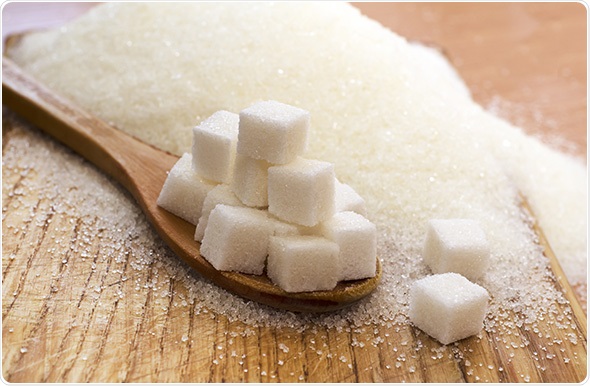By Sally Robertson, BSc - Medical News
New World Health Organization guidelines recommend that people reduce their daily free sugar intake to less than 10% of their total calorie intake, with a reduction to 5% representing a further target.
“Making policy changes to support this will be key if countries are to live up to their commitments to reduce the burden of noncommunicable diseases,” says Dr Francesco Branca, Director of WHO’s Department of Nutrition for Health and Development.

Gayvoronskaya_Yana / Shutterstock.com
Free sugars are the monosaccharides and disaccharides added to food and drink by manufacturers, cooks or consumers, as well as the sugars that occur naturally in fruit juice or honey, for example. The WHO guideline does not refer to the sugars found in fresh fruit and vegetables or milk, as no evidence exists to suggest that those sugars adversely affect our health.
Alison Tedstone, Director of the Diet and Obesity team, Public Health England, says surveys show that the average current daily free sugar intake among adults in the UK accounts for 11.6% of the total calorie intake, while among children it accounts for 15.2%.
The recommendation of less than 10% is based on a review of scientific evidence showing that a lower sugar intake among adults is associated with lower body weight and, among children, it is associated with a reduced likelihood of overweight and obesity. Furthermore, the evidence supports that an intake higher than 10% is associated with increased rates of tooth decay.
Dr Branca says:
We have solid evidence that keeping intake of free sugars to less than 10% of total energy intake reduces the risk of overweight, obesity and tooth decay
The quality of the evidence reviewed means that WHO can rank the recommendation as “strong” and therefore suitable for implementation as policy in most situations. The plans will now be subjected to public consultation, with firm recommendations expected to be put in place this summer and translated into food-based dietary guidelines and public health interventions to reduce sugar intake. Examples of such interventions include a reduction in the marketing of sugary food to children and the introduction of nutrition labeling for food products.
However, due to obesity rates rising worldwide, many experts believe that a goal of less than 10% is still too high and campaign group “Action for Sugar” is pressing for 5% to become the new target. Although the WHO now acknowledge that further health benefits can be achieved if the 5% goal is implemented, only three nationwide studies have demonstrated those health benefits. The WHO can therefore only make a “conditional” rather than “strong” recommendation for issuing this 5% goal for implementation.
A conditional recommendation refers to one that would probably be beneficial if adhered to but where the associated trade-offs between the desirable and undesirable effects still need to be clarified before the recommendation can be adopted as policy.
UK campaigners say it is a "tragedy" that it has taken 10 years for the WHO to think about changing its advice on sugar intake.
“We should aim for 5% if we can,” says Branca.
The update to the WHO guideline is part of the organization’s efforts to improve current dietary guidelines about preventing non-communicable diseases such as diabetes. The guidelines on sugar intake should be used in combination with other nutrition recommendations and goals, particularly those related to the intake of fats and fatty acids such as trans-fat and saturated fat.
Sources:
- http://www.bbc.co.uk/news/health-26449497
- http://www.who.int/mediacentre/news/releases/2015/sugar-guideline/en/
Related:


 The “Not So Safe” or No-No Pet Food List
The “Not So Safe” or No-No Pet Food List